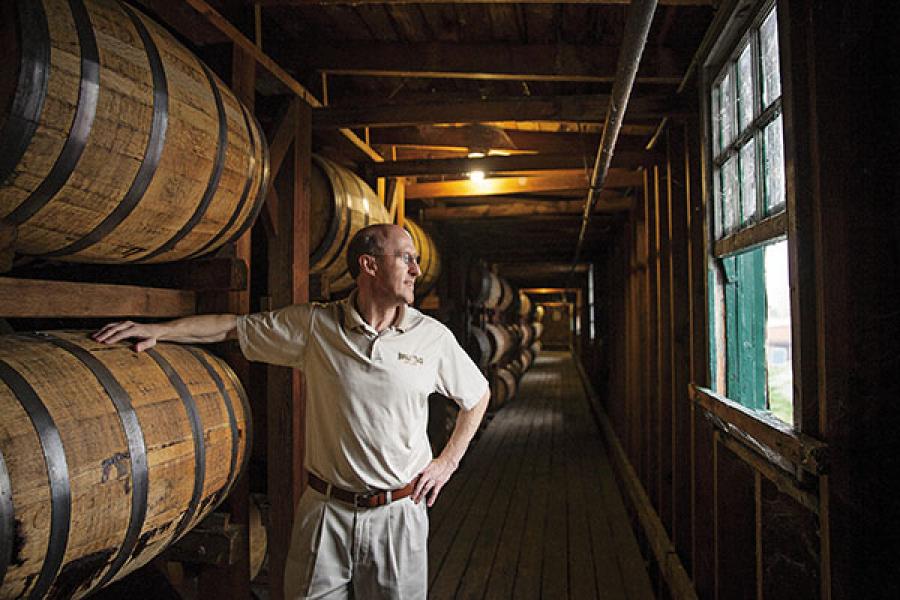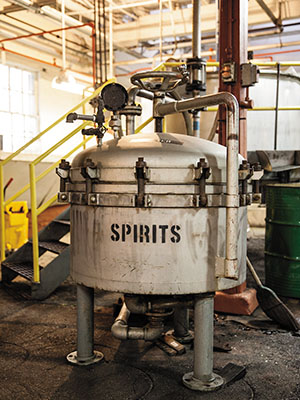
The Making of $5,000 Bourbon
Kentucky's Buffalo Trace Distillery has found the right ingredients for making some of the world's finest whiskeys. A jigger of mystery helps, too. Particularly when selling storied spirits like Pappy Van Winkle
When the Sazerac Co bought a run-down whiskey factory on the banks of the Kentucky River in 1992, it renovated the compound and rechristened it Buffalo Trace Distillery, after the trails cut into the countryside by bison centuries ago. Yet the name hanger prompted a question as predictable as the ancient buffalo’s migration: Why wasn’t there a bourbon actually called Buffalo Trace? Customers walked away baffled. Sazerac clearly had misjudged its audience.
The answer arrived in the form of 78-year-old Elmer T Lee, who had retired a decade earlier as the factory’s master distiller. Sazerac asked Lee to search the warehouses for a bourbon recipe the former owners hadn’t taken to market. He carried out a mellow elixir with hints of toffee and brown sugar. Buffalo Trace Bourbon hit the shelves a short time later, which led to another question once it was in production. “So, Elmer, how much of it do we have?” asked Sazerac CEO Mark Brown, a bald-headed Brit with an unshakable English accent. Lee smiled widely at him. “Not very much.” Great whiskey—but not enough of it. The Great Bourbon Shortage has caused a run on many liquor stores; Buffalo Trace’s solution is to provide small batches of quality bourbons rather than a great quantity of a mass-produced whiskey. Buffalo Trace is more widely known today than its corporate parent, Sazerac, which is owned by the New Orleans-based Goldring family and, yes, named after the cocktail invented in 1838. While Sazerac operations stretch across the US and into Canada, Buffalo Trace has become its most important asset. From its stills come Sazerac’s finest spirits. Not just the namesake bourbon, but also other top-notch whiskeys such as WL Weller, George T Stagg, Blanton’s—and the granddaddy of ’em all, Pappy Van Winkle. That wheated wonder is considered the nation’s most coveted bourbon and one of the best whiskeys in the world. And unquestionably the most elusive.
Buffalo Trace’s success in the past decade is the result of calculated alchemy and strategic acquisitions. Fame has been achieved (it has been named Whiskey Magazine’s Distiller of the Year five times in 14 years), while simultaneously cultivating an air of mystery. As for production, Buffalo Trace has reached 110,000 barrels annually, or 3 million cases, an approximately nine-fold increase since 1992. It’s still insufficient to meet the skyrocketing demand for bourbon, and for bourbon from Buffalo Trace in particular.
The men who sweated over stills on that patch of bluegrass haven’t always been as prosperous. They could sooner expect a once-a-decade flood than regular profits. A banker by the name of EH Taylor was there in 1870. Known locally as Colonel Taylor, he was never anything other than a civilian—and a prosperous one until his $72,000 investment in the distillery evaporated. Another owner, Albert Blanton, found himself pressed into making munitions and synthetic rubber at his distillery during World War I and was then nearly ruined by Prohibition.
By the end of World War II, Americans had lost their taste for bourbon. (They drink vodka and Canadian Club on Mad Men for a reason.) The distillery that eventually became Buffalo Trace struggled through the post-war decades by mostly making rotgut. (They did one thing right: In 1984, Elmer Lee introduced Blanton’s, the first-ever single-barrel bourbon.) Times were tough enough to lead to experiments in distilling expired soda pop. Sheep grazed as lawnkeepers. A barbed-wire fence encircled the property, much of which went unused.
“It looked like a prison camp, big and forlorn,” recalls Brown, who in 1997 came back to the Sazerac Co, where he had worked for 11 years. In the years following his return, the Buffalo Trace Distillery has been completely renovated. It now features 150 acres of well-kept lawns and gardens ringed by a green picket fence. Buildings are carefully preserved (the oldest is a currently unused stone cottage dating back to 1792).
The public can visit the distillery— though it’s not on Kentucky’s famed Bourbon Trail tour—but Buffalo Trace maintains a Wonka-esque quality in the way its executives relish reclusiveness. It is not uncommon for the company to answer media requests with an insistence that it prefers to remain mysterious. Especially when it comes to Pappy Van Winkle. The Van Winkle brand was part of Buffalo Trace’s M&A binge—20 or so businesses acquired since 1997—and came into the company portfolio in 2002 through a joint venture with the Van Winkle family. Buffalo Trace oversaw production while the clan concentrated on the marketing, mostly through tastings and brand dinners.
They also played up the origin story of how Julian Van Winkle Jr revived an old family recipe, with its unusual ingredients, to save their business. Van Winkle bourbons use corn, barley and, most important, wheat in place of rye for a smoother blend. Consumers were soon enchanted. And the brand’s scarcity drove them even harder to find it.
Demand was already feverishly high before the case of the missing cases. In 2013, 195 bottles of 20-year-old Pappy Van Winkle bourbon and 27 bottles of the rye were stolen from a Buffalo Trace warehouse. “You can still get the $10,000 reward,” says Brown. “Which will buy you about half a bottle.” He’s only half-kidding. The 23-year-old Pappy sells for $250 when available in a store but has fetched as much as $5,000 in the black market. The fortunate few who’ve sipped it praise the way hints of citrus complement vanilla, maple and honey.
And for those who can’t procure a bottle of Pappy, Buffalo Trace has shown a consistent flair for innovation in the whiskey market. One particularly well-received new brand is Stagg Jr—winner of a double gold medal at the World Spirits Competition in San Francisco—named after former owner George T Stagg. The whiskey, which tastes of sweet chocolate and spicy rye, is bottled at barrel strength of 136.6 proof. In fact, it’s hard to say how many different whiskeys Buffalo Trace has ageing at any given time, since there are many small batches of experimental distillations that push the number well past 30.
And at the same time, Buffalo Trace is specialising, overall production is increasing— and, yes, it is making more Pappy Van Winkle. (Brown won’t comment on the exact figures, however.) But Buffalo Trace suffers from a fundamental problem that every distillery faces: Its finest liquor needs to age, and it went into barrels at a time when the company’s forecast didn’t anticipate Americans starting to knock back bourbon with such enthusiasm. “There’s nothing any of us can do except apologise for not having a better crystal ball,” says Brown. For now, planning meetings happen twice annually, and Buffalo Trace metes out its allocations to distributors monthly, not yearly; it fears distributors would blow through it in one shot otherwise. Beyond that, Buffalo Trace announced this spring that it would spend $20 million on a new warehouse for finished cases. They used to go in the same building as the barrels, but with more barrels needed for production, the cases need a new home. (And presumably solid security.)
Scan those stacked cases and the names quickly resonate with students of the Buffalo Trace whiskeys. There are EH Taylor (tasting of caramel corn and butterscotch), a brand created by the sham soldier himself; Blanton’s (orange and cloves), named after another former owner; even one honouring the man who came through in a pinch, Elmer T Lee (vanilla and old leather). As for Brown, he has left strict instructions that Buffalo Trace should never create a particular brand—one named after him. Raising the occasional glass in his honour might suffice.
(This story appears in the 19 September, 2014 issue of Forbes India. To visit our Archives, click here.)
















